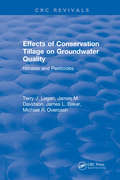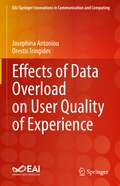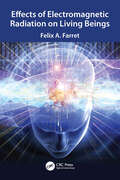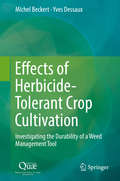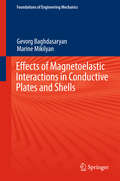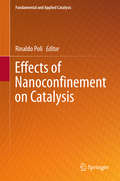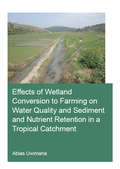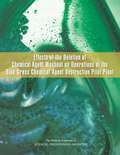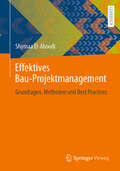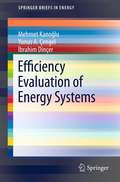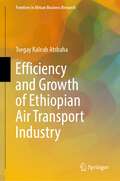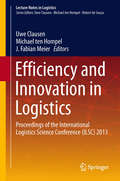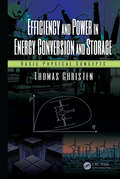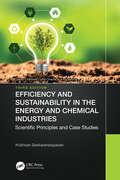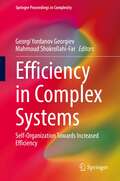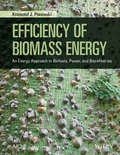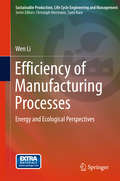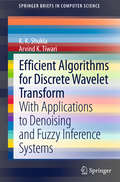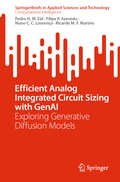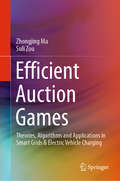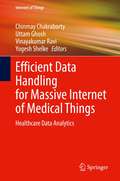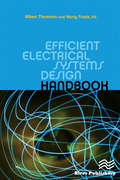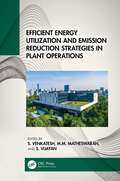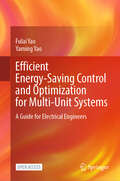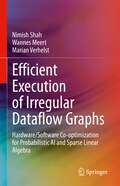- Table View
- List View
Effects Conservation Tillage On Ground Water Quality: Nitrates and Pesticides
by Terry J LoganNowadays the environmental sustainability of the cropping systems is increasingly requested by the consumers. Conventional tillage practices, totally turning over the soil between the vineyard rows, may cause erosion due to rain as well as structure destruction of the soil in the long term. Conservation tillage is a soil management technique, poorly widespread in Sardinia, allowing cover cropping between vineyard rows. Furthermore, this technique makes the canopy development control of herbage possible by cutting it up during specific phenological phases. Conservation tillage usually involves direct benefits to farmers such as increasing soil fertility as well as reductionof tillage costs, soil erosion and carbon dioxide (CO2) emissions in the atmosphere. This long term trial, during at least five years aims to assess the conservation tillage impact on chemical-physical soil characteristics in comparison with traditional tillage by evaluating the change of organic matter, C.E.C. and availability of major plant nutrients in the soil and to estimate their probable rise. The field plots are located in a 35% slope condition vineyard, showing massive erosion problem and organic matter low content. A split/plot design with four replications was set up, with the comparison between conservation and traditional tillage apart as main plots. Moreover, the effects of two different irrigation levels were evaluated in the subplots of each main plot. At the beginning of the trial (2011) a pedological survey was made. Three soil profiles were described and sampled along the field slope and soil sampling in each plot were made both to characterize the soil and to find the zero point. The soil chemical and physical characteristics were monitored through a second soil sampling made at the end of 2013. Conservation tillage caused increasing organic matter content and C.E.C. values. As for major plant nutrients in soil, results were more uncertain. Grapevine yield and quality parameters did not show any negative effect when passing from conventional to conservation tillage techniques. The trial provided a preliminary positive evaluation of conservation tillage. However, more years are required to confirm this trend.
Effects of Data Overload on User Quality of Experience (EAI/Springer Innovations in Communication and Computing)
by Josephina Antoniou Orestis TringidesThis book introduces a unique perspective on the use of data from popular emerging technologies and the effect on user quality of experience (QoE). The term data is first refined into specific types of data such as financial data, personal data, public data, context data, generated data, and the popular big data. The book focuses the responsible use of data, with consideration to ethics and wellbeing, in each setting. The specific nuances of different technologies bring forth interesting case studies, which the book breaks down into mathematical models so they can be analyzed and used as powerful tools. Overall, this perspective on the use of data from popular emerging technologies and the resulting QoE analysis will greatly benefit researchers, educators and students in fields related to ICT studies, especially where there is additional interest in ethics and wellbeing, user experience, data management, and their link to emerging technologies.
Effects of Electromagnetic Radiation on Living Beings
by Felix A. FarretThe objective of this book is to show in detail how electromagnetic waves existing in the environment can affect the electrochemical currents present in the brains and bodies of living beings that serve to communicate with their internal organs as well as with other living beings. These electromagnetic waves are distributed intensively by current means of communication (television, cell phones, radar, medical equipment, electrical machines, electrical networks, etc.) and by the stars in the Universe. Such waves can affect in one way or another the electrochemical currents of living beings, which seem to be currently interpreted as sensations, hypnosis, telepathy, intuition, spells, mediumship, visions and precognition, as well as other less widespread forms, such as telekinesis, radiesthesia, clairvoyance, precognition and teleportation. Several world-famous examples of these possibilities are illustrated in the final chapter of this book.Key Features: 14 examples of diverse international case studies included Challenges conventional ways of thinking by exploring the intersection of electromagnetic waves and extrasensory perception Equips readers with insights into the various effects of electromagnetic waves in daily life, which promotes awareness of their environment and its different influences and how they impact people Provides an engineering framework for understanding extrasensory beliefs and aims to explain the concept of historical brain believing in a better manner
Effects of Herbicide-Tolerant Crop Cultivation
by Michel Beckert Yves DessauxOverall, this work identifies key points to be taken into account when drawing up guidelines that govern the use of herbicide-tolerant (HT) crops in order to preserve the effectiveness of this innovation over time. This multidisciplinary expert report, based on an international literature review, assesses the effects of the cultivation of crops possessing HT traits. HT crops may appear to be useful complementary tools when farmers are facing certain difficult weed-management situations or in the context of a diversification of weed-control strategies. Their repeated use, however, can rapidly induce changes in the weed flora that can constitute more complex challenges in terms of weed control. Issues coming up with the development of agricultural production systems including HT crops are the objects of this expert report: what are the perceptions of these varieties by society and the reasons for their adoption by farmers? Are the savings on herbicides promoted by seed companies long-lasting? Can the cultivation of HT crops impact biodiversity?
Effects of Magnetoelastic Interactions in Conductive Plates and Shells
by Gevorg Baghdasaryan Marine MikilyanThis book investigates the stability and vibrations of conductive, perfectly conductive and superconductive thin bodies in electromagnetic fields. It introduces the main principles and derives basic equations and relations describing interconnected mechanical and electromagnetic processes in deformable electro conductive bodies placed in an external inhomogeneous magnetic field and under the influence of various types of force interactions. Basic equations and relations are addressed in the nonlinear formulation and special emphasis is placed on the mechanical interactions of superconducting thin-body plates with magnetic fields.
Effects of Nanoconfinement on Catalysis
by Rinaldo PoliThis book highlights the recent advances and state of the art in the use of functionalized nanostructured environments on catalysis. Nanoconfinements considered include well-defined molecular cages, imprinted self-assembled supramolecules, polymers made by living or controlled polymerization, metallorganic frameworks, carbon nanotubes, mesoporous inorganic solids, and hybrids thereof. Advantages of nanoconfinement of catalysts discussed include higher activities, improved selectivities, catalyst stabilization, cooperativity effects, simplified protocols for cascade syntheses, better catalyst recovery, and recyclability. The multiple applications that these materials offer are revolutionizing industrial sectors such as energy, electronics, sensors, biomedicine, and separation technology.
Effects of Wetland Conversion to Farming on Water Quality and Sediment and Nutrient Retention in a Tropical Catchment (IHE Delft PhD Thesis Series)
by Abias UwimanaThe study used a combination of landscape-scale synoptic surveys (catchment, reaches) and mesocosm surveys (experimental plots) to assess the impacts of conversion of natural valley-bottom wetlands to farming land on the water quality and retention of sediment and nutrients. The results showed that temperature, pH, electrical conductivity and dissolved oxygen concentration decreased, and total suspended solids (TSS) increased with storm water increase. Nitrogen (TN) and phosphorus (TP) accumulated in the catchment during the dry season and washed into the water courses during the early stages of the higher flows, with subsequent lower concentrations at the end of the rains due to dilution. Large proportions of the annual loads of TSS, TP and TN (93%, 60% and 67%, respectively) were transported during rainfall events that occurred in 115 days. Fishponds acted as temporal traps of TSS, TN and TP at the early stages of farming, and were a source of and TN and TP at the end of the farming period, in contrast to rice farming that generated sediments and nutrients early in the farming period and trapped them at the end of the farming season. Wetlands mostly acted as sinks but sometimes as a source of sediment and nutrients.
Effects of the Deletion of Chemical Agent Washout on Operations at the Blue Grass Chemical Agent Destruction Pilot Plant
by Engineering Medicine National Academies of SciencesThe United States manufactured significant quantities of chemical weapons during the Cold War and the years prior. Because the chemical weapons are aging, storage constitutes an ongoing risk to the facility workforces and to the communities nearby. In addition, the Chemical Weapons Convention treaty stipulates that the chemical weapons be destroyed. The United States has destroyed approximately 90 percent of the chemical weapons stockpile located at seven sites. As part of the effort to destroy its remaining stockpile, the Department of Defense is building the Blue Grass Chemical Agent Destruction Pilot Plant (BGCAPP) on the Blue Grass Army Depot (BGAD), near Richmond, Kentucky. The stockpile stored at BGAD consists of rockets and projectiles containing the nerve agents GB and VX and the blister agent mustard. Continued storage poses a risk to the BGAD workforce and the surrounding community because these munitions are several decades old and are developing leaks. Due to public opposition to the use of incineration to destroy the BGAD stockpile, Congress mandated that non- incineration technologies be identified for use at BGCAPP. As a result, the original BGCAPP design called for munitions to be drained of agent and then for the munition bodies to be washed out using high-pressure hot water. However as part of a larger package of modifications called Engineering Change Proposal 87 (ECP-87), the munition washout step was eliminated. Effects of the Deletion of Chemical Agent Washout on Operations at the Blue Grass Chemical Agent Destruction Pilot Plant examines the impacts of this design change on operations at BGCAPP and makes recommendations to guide future decision making.
Effektives Bau-Projektmanagement: Grundlagen, Methoden und Best Practices
by Shymaa El-AboodiDieses Lehrbuch ist eine pragmatische Mischung aus fundiertem Wissen, langjähriger Erfahrung und umfassender praktischer Umsetzung der wesentlichen Methoden des Projektmanagements. Der systematische Aufbau enthält praktische Anwendungshilfen für die Projektarbeit. Das Lehrbuch gibt einen verständlichen Überblick über die Methoden, Werkzeuge und Best Practices, die für eine effiziente Realisierung von Bau-Projekten genutzt werden können. Das Buch möchte Einsteiger:innen in die Thematik dabei unterstützen, die Herausforderung der Projektarbeit zu meistern und ihre Fähigkeiten und Kenntnisse als Projekt-Manager:in weiterzuentwickeln.
Efficiency Evaluation of Energy Systems
by Ibrahim Dincer Mehmet Kanoğlu Yunus A. ÇengelEfficiency is one of the most frequently used terms in thermodynamics, and it indicates how well an energy conversion or process is accomplished. Efficiency is also one of the most frequently misused terms in thermodynamics and is often a source of misunderstanding. This is because efficiency is often used without being properly defined first. This book intends to provide a comprehensive evaluation of various efficiencies used for energy transfer and conversion systems including steady-flow energy devices (turbines, compressors, pumps, nozzles, heat exchangers, etc.), various power plants, cogeneration plants, and refrigeration systems. The book will cover first-law (energy based) and second-law (exergy based) efficiencies and provide a comprehensive understanding of their implications. It will help minimize the widespread misuse of efficiencies among students and researchers in energy field by using an intuitive and unified approach for defining efficiencies. The book will be particularly useful for a clear understanding of second law (exergy) efficiencies for various systems. It may serve as a reference book to the researchers in energy field. The definitions and concepts developed in the book will be explained through illustrative examples.
Efficiency and Growth of Ethiopian Air Transport Industry (Frontiers in African Business Research)
by Tsegay Kaleab AtsbahaThis book evaluates the efficiency and growth of the Ethiopian air transport sector through careful analysis. It provides essential research input for air transport industry practitioners in planning and resource management as well as for academics of advanced efficiency analysis who need to work and study in airports and the airline industry. The book analyzes the theoretical and practical implications of air transport growth determinants, airports' cost and production efficiency, including labor use efficiency by taking their respective determinant factors. The findings and policy implications of each research work provide important inputs for government policymakers and air transport planners to consider the causality of economic growth versus airlines growth and other determinants, to take lessons on the proper resource allocation in the application of airport cost and production efficiency, human capital, investment cost, price of capital, and labor inputs during the development and expansion of airports and airlines. This book is the first of its kind on the Ethiopian air transport industry and serves as a much-needed reference for the African air transport industry as well as other developing countries in terms of airport costs, production, labor use efficiency and airline growth perspectives.
Efficiency and Innovation in Logistics: Proceedings of the International Logistics Science Conference (ILSC) 2013
by Michael Ten Hompel Uwe Clausen Fabian MeierThe importance of logistics in all its variations is still increasing. New technologies emerge, new planning methods and algorithms are developed, only to face a market with a growing complexity and the need of weighting monetary costs against ecological impact. Mastering these challenges requires a scientific viewpoint on logistics, but always with applications in mind. This volume presents up-to-date logistics research in all its diversity and interconnectedness. It grew out of the "International Logistics Science Conference" (ILSC) held in Dortmund in September 2013, bringing together leading scientists and young academics from nine different countries. The conference was jointly organized by the "Efficiency Cluster Logistics" and the "Fraunhofer Institute for Material Flow and Logistics". The Program Committee used a double blind review process to choose the 12 strongest contributions, which were then grouped in four areas: - Sustainability logistics, including electric mobility, smart information, communication technologies and corporate social responsibility management - Intralogistics, including the detection of autonomous vehicles, 3D computer vision and sensor functions for forklift trucks - Transport logistics, including distribution centre organization, delivery performance in railway systems and logistics reference modelling - Logistics facilities, including environmental impact of container ports, parcel sorting systems and model based systems engineering.
Efficiency and Power in Energy Conversion and Storage: Basic Physical Concepts
by Thomas ChristenThis book provides fundamental theoretical concepts for the understanding, the modelling, and the optimisation of energy conversion and storage devices. The discussion is based on the general footing of efficiency-power relations and energy-power relations (Ragone plots). Efficiency and Power in Energy Conversion and Storage: Basic Physical Concepts, is written for engineers and scientists with a bachelor-degree level of knowledge in physics. It contains: <li>An introductory motivation of the topic <li>A review on equilibrium thermodynamics <li>A primer to linear non-equilibrium thermodynamics and irreversible processes <li>An introduction to endo-reversible thermodynamics <li>The basics on the theory of Ragone plots <li>Derivations of efficiency-power relations or Ragone plots for illustrative examples like heat engines, batteries, capacitors, kinetic energy storage devices, solar power, photodiodes, electro-motors, transformers, and flow turbines <li>An excursion to impedance matching and the optimization of technical devices with respect to economic and related objectives
Efficiency and Sustainability in the Energy and Chemical Industries: Scientific Principles and Case Studies (Green Chemistry and Chemical Engineering)
by Krishnan SankaranarayananUsing classic thermodynamic principles as the point of departure, this new edition of a popular resource supplies the understanding and tools required to measure process ef ciency and sustainability with much improved accuracy. Exploring the driving forces in the chemical and power industries, Efficiency and Sustainability in the Energy and Chemical Industries: Scientific Principles and Case Studies, Third Edition investigates why losses occur and explains how to reduce them. It focuses on the changing roles of refining and chemicals in industry and how the industry is transforming itself, and considers economics as a key enabler to look at technology choices and whether shareholder returns will be there. • Includes new chapters on plastics recycling technologies and challenges, low carbon energy sources, the changing energy mix, and project economics, taxes, and subsidies. • Illustrates techniques with wide-ranging case studies related to energy conversion, mining, and the chemical industries as well as examples and problems. • Considers engineering layouts that reduce the environmental impact of chemical operations. • Explains how to use energy analysis to accurately assess the quality and performance of chemical processes. • Supplies quantitative tools for analyzing sustainability and efciency. • Investigates the challenges of the hydrogen economy and CO2 and low carbon. • Discusses plastics recycling, economics, and a changing energy mix. Complete with the keys to quanti cation of process ef ciency and sustainability, this cutting-edge book is the ideal guide for those engaged in the transition from fossil-based fuels to renewable and sustainable energy sources using low-waste procedures.
Efficiency in Complex Systems: Self-Organization Towards Increased Efficiency (Springer Proceedings in Complexity)
by Georgi Yordanov Georgiev Mahmoud Shokrollahi-FarThis book uses new ideas and language for understanding how self-organization and complexity trend toward increased efficiency. Different measures for efficiency from multiple disciplines are used to probe the ones that provide the most insight. One major goal is to seek a common framework to trace the increase of efficiency as a measure of the level of organization and evolutionary stage of a complex system. The chapters come from a satellite meeting hosted at the Conference on Complex Systems, in Cancun, 2017. The contributions will be peer-reviewed and contributors from outside the conference will be invited to submit chapters to ensure full coverage of the topics. This text will appeal to students and researchers working on complex systems and efficiency.
Efficiency of Biomass Energy: An Exergy Approach to Biofuels, Power, and Biorefineries
by Krzysztof J. PtasinskiDetails energy and exergy efficiencies of all major aspects of bioenergy systems Covers all major bioenergy processes starting from photosynthesis and cultivation of biomass feedstocks and ending with final bioenergy products, like power, biofuels, and chemicals Each chapter includes historical developments, chemistry, major technologies, applications as well as energy, environmental and economic aspects in order to serve as an introduction to biomass and bioenergy A separate chapter introduces a beginner in easy accessible way to exergy analysis and the similarities and differences between energy and exergy efficiencies are underlined Includes case studies and illustrative examples of 1st, 2nd, and 3rd generation biofuels production, power and heat generation (thermal plants, fuel cells, boilers), and biorefineries Traditional fossil fuels-based technologies are also described in order to compare with the corresponding bioenergy systems
Efficiency of Manufacturing Processes
by Wen LiThis monograph presents a reliable methodology for characterising the energy and eco-efficiency of unit manufacturing processes. The Specific Energy Consumption, SEC, will be identified as the key indicator for the energy efficiency of unit processes. An empirical approach will be validated on different machine tools and manufacturing processes to depict the relationship between process parameters and energy consumptions. Statistical results and additional validation runs will corroborate the high level of accuracy in predicting the energy consumption. In relation to the eco-efficiency, the value and the associated environmental impacts of manufacturing processes will also be discussed. The interrelationship between process parameters, process value and the associated environmental impact will be integrated in the evaluation of eco-efficiency. The book concludes with a further investigation of the results in order to develop strategies for further efficiency improvement. The target audience primarily comprises researchers and experts in the field, but the book may also be beneficial for graduate students.
Efficient Algorithms for Discrete Wavelet Transform
by K K Shukla Arvind K. TiwariDue to its inherent time-scale locality characteristics, the discrete wavelet transform (DWT) has received considerable attention in signal/image processing. Wavelet transforms have excellent energy compaction characteristics and can provide perfect reconstruction. The shifting (translation) and scaling (dilation) are unique to wavelets. Orthogonality of wavelets with respect to dilations leads to multigrid representation. As the computation of DWT involves filtering, an efficient filtering process is essential in DWT hardware implementation. In the multistage DWT, coefficients are calculated recursively, and in addition to the wavelet decomposition stage, extra space is required to store the intermediate coefficients. Hence, the overall performance depends significantly on the precision of the intermediate DWT coefficients. This work presents new implementation techniques of DWT, that are efficient in terms of computation, storage, and with better signal-to-noise ratio in the reconstructed signal.
Efficient Analog Integrated Circuit Sizing with GenAI: Exploring Generative Diffusion Models (SpringerBriefs in Applied Sciences and Technology)
by Pedro H. M. Eid Filipe P. Azevedo Nuno C. C. Lourenço Ricardo M. F. MartinsThis book focuses on the automation of analog integrated circuit design, particularly the sizing process. It introduces an innovative approach leveraging generative artificial intelligence, specifically denoising diffusion probabilistic models (DDPM). The proposed methodology provides a robust solution for generating circuit designs that meet specific performance constraints, offering a significant improvement over conventional techniques. By integrating advanced machine learning models into the design workflow, the book showcases a transformative way to streamline the process while maintaining accuracy and reliability.
Efficient Auction Games: Theories, Algorithms and Applications in Smart Grids & Electric Vehicle Charging
by Zhongjing Ma Suli ZouThis book focuses on the design of efficient & dynamic methods to allocate divisible resources under various auction mechanisms, discussing their applications in power & microgrid systems and the V2G & EV charging coordination problems in smart grids. It describes the design of dynamic methods for single-sided and double-sided auction games and presents a number of simulation cases verifying the performances of the proposed algorithms in terms of efficiency, convergence and computational complexity. Further, it explores the performances of certain auction mechanisms in a hierarchical structure and with large-scale agents, as well as the auction mechanisms for the efficient allocation of multi-type resources. Lastly, it generalizes the main and demonstrates their application in smart grids. This book is a valuable resource for researchers, engineers, and graduate students in the fields of optimization, game theory, auction mechanisms and smart grids interested in designing dynamic auction mechanisms to implement optimal allocation of divisible resources, especially electricity and other types of energy in smart grids.
Efficient Data Handling for Massive Internet of Medical Things: Healthcare Data Analytics (Internet of Things)
by Chinmay Chakraborty Uttam Ghosh Vinayakumar Ravi Yogesh ShelkeThis book focuses on recent advances and different research areas in multi-modal data fusion under healthcare informatics and seeks out theoretical, methodological, well-established and validated empirical work dealing with these different topics. This book brings together the latest industrial and academic progress, research, and development efforts within the rapidly maturing health informatics ecosystem. Contributions highlight emerging data fusion topics that support prospective healthcare applications. The book also presents various technologies and concerns regarding energy aware and secure sensors and how they can reduce energy consumption in health care applications. It also discusses the life cycle of sensor devices and protocols with the help of energy-aware design, production, and utilization, as well as the Internet of Things technologies such as tags, sensors, sensing networks, and Internet technologies. In a nutshell, this book gives a comprehensive overview of the state-of-the-art theories and techniques for massive data handling and access in medical data and smart health in IoT, and provides useful guidelines for the design of massive Internet of Medical Things.
Efficient Electrical Systems Design Handbook
by Albert Thumann Harry FranzNow you can achieve optimum performance and efficiency in the design of electric systems for virtually any size or type of building or industrial facility utilizing the state-of-the-art methodologies detailed in this comprehensive handbook. Step-by-step guidelines take you through each phase of design, covering equipment selection, power distribution system analysis, conduit and conductor sizing, lighting system design, control systems, electronic instrumentation, protective relaying, energy management systems, power quality, variable speed drives, motor selection, and more. The latest codes (NEC 2008) as well as currently available equipment are referenced. Numerous examples and simulation exercises are included, along with detailed design examples. Fully illustrated with many useful diagrams and tables, this book is a practical guide for electrical engineers, plant and facility engineers, and other professionals responsible for implementing or overseeing the design of facility electrical systems.
Efficient Energy Utilization and Emission Reduction Strategies in Plant Operations
by S. Venkatesh S. Vijayan M. M. MatheswaranEfficient Energy Utilization and Emission Reduction Strategies in Plant Operations summarizes technological advancements in effective energy utilization in plant operations. It provides optimal geometrical parameters to design emission control equipment for minimum energy consumption.Focusing on current and emerging technological innovations for improving the energy efficiencies of processes in several industries, such as manufacturing, mining, dairy, and other processing industries, this book explores pollution control and design methods for low-carbon environments. It also covers reductions in greenhouse gas emissions through innovative co-production of bio-oil in combined heat and power plants.This book will be a useful reference for graduate students and academic researchers in the fields of energy management, plant operations, sustainable engineering, environmental engineering, and mechanical/industrial engineering.
Efficient Energy-Saving Control and Optimization for Multi-Unit Systems: A Guide for Electrical Engineers
by Fulai Yao Yaming YaoThis open access book focuses on energy efficiency optimization control methods and energy efficiency optimization methods. The mathematical proof of the multi-unit operation energy efficiency prediction theory and engineering application solutions are given. By analyzing the commonalities of the efficiency curves of different devices and using the quantum optimization method proposed in the book, a nonlinear, integer-real-number mixed energy efficiency optimization method under constrained conditions has been demonstrated. Twelve application cases, including hydropower plants, transmission networks, distribution stations, water pumping stations, high-speed trains, electric vehicles, electric ships, central air conditioning systems, central heating systems, wind power hydrogen production and multi-engine rockets, have been studied in detail. A key feature of this book is that the energy efficiency optimization of the system can be achieved without establishing a complex mathematical model of the multi-unit system, this method is simple, practical, widely applicable and versatile. It is particularly suitable for readers who are interested in learning about energy efficiency optimization and energy saving and carbon reduction solutions. This book can benefit researchers, engineers and graduate students in the fields of electrical and electronic engineering, control engineering, power engineering and energy engineering.
Efficient Execution of Irregular Dataflow Graphs: Hardware/Software Co-optimization for Probabilistic AI and Sparse Linear Algebra
by Marian Verhelst Wannes Meert Nimish ShahThis book focuses on the acceleration of emerging irregular sparse workloads, posed by novel artificial intelligent (AI) models and sparse linear algebra. Specifically, the book outlines several co-optimized hardware-software solutions for a highly promising class of emerging sparse AI models called Probabilistic Circuit (PC) and a similar sparse matrix workload for triangular linear systems (SpTRSV). The authors describe optimizations for the entire stack, targeting applications, compilation, hardware architecture and silicon implementation, resulting in orders of magnitude higher performance and energy-efficiency compared to the existing state-of-the-art solutions. Thus, this book provides important building blocks for the upcoming generation of edge AI platforms.
